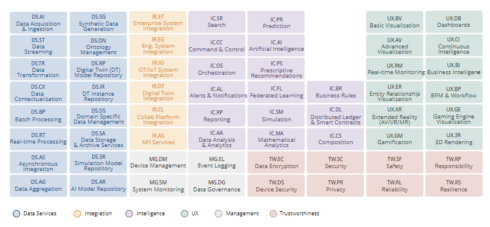
The Digital Twin Consortium has announced an update to its Digital Twin Capabilities Periodic Table (CPT), its definition framework for creating and operating digital twins.
The CPT groups capabilities around common characteristics, much as the chemical periodic table groups things such as atomic number and properties. The update helps organizations looking to use digital twins for particular use cases collaborate and make those capability requirements explicit, according to a statement released by the consortium, which operates under the auspices of The Object Management Group.
“We are laying a robust foundation for the evolution of the Capabilities Periodic Table with a structured approach and integration of new capabilities like responsibility and search,” Dan Isaacs, GM & CTO of the Digital Twin Consortium, said in the announcement. “We’re already working on V2 of the CPT, with plans to increase interoperability with AI, better incorporate geospatial and related spatial computing topics, and provide more guidance on aligning use cases.”
According to the consortium, several enhancements were introduced in version 1.1 of the CPT, including making responsibility a core trustworthiness capability, which wraps in ethics, ESG criteria, AI explainability and fairness. The ability to manage and navigate through complex datasets within their own environments is also now a fundamental capability for digital twins.
The release also consolidates virtual reality and augmented reality into what the consortium is calling extended reality, following the consolidation of these technologies and making immersive experiences more integrated, according to the company.
The update also recognizes that the variety of domain-specific data types and temporal stores are essential for digital twins, and so has reclassified them under “Domain Specific Data Management.” Further, the release moves beyond sequential numbering by adopting structured abbreviations for each capability, and the consortium has provided a detailed mapping of version 1.0 to 1.1, according to its announcement.
“CPT Version 1.1 provides important additions that continue to emphasize capabilities over specific technologies and includes a revised machine-readable schema for greater ease of implementation,” said Pieter Van Schalkwyk, CEO of XMPro and co-chair of the AI Joint Working Group, in the consortium’s announcement. “Serving as the key part of the Composability Framework, the CPT facilitates greater flexibility and innovation, ensuring that digital twin system development focuses on interoperability, scalability, design reuse, and [is] aligned with the evolving needs of businesses.”





